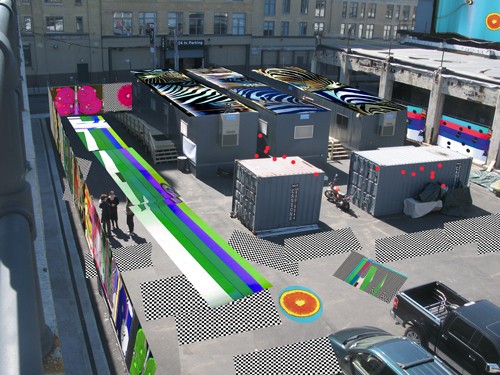Whitney Museum Launches Downtown Series
Commissions for Site of New Building in Meatpacking District
By: Bob Fowler - Apr 16, 2010
This May the Whitney Museum of American Art will launch a series of large-scale, commissioned works on the site of its future downtown building at the corner of Gansevoort and Washington Streets in Manhattan's Meatpacking District. The three commissioned projects, Whitney on Site: New Commissions Downtown, which will be on view throughout the summer and into October, will respond to the site's dynamic urban context and herald plans to bring a downtown Whitney to the neighborhood.Adam D. Weinberg, the Whitney's Alice Pratt Brown Director, noted, "Each of the invited artists is going to take the neighborhood's diverse viewers into account, just as they will consider the changing viewpoints of pedestrians, vehicles, and visitors to the High Line, which overlooks the property from the east. The project will both animate and reflect on the Museum's new site and surroundings. We are delighted to be part of this exciting area and think this is a great way to bring the Whitney's creative presence downtown."
The Whitney's curatorial team has invited three artists to participate in this initiative: the collaborative team of GuytonWalker, comprising Wade Guyton (b. 1972) and Kelley Walker (b. 1969); Tauba Auerbach (b. 1981); and Barbara Kruger (b. 1945). Each of these artists has a rich history with the Whitney.
They are all represented in the museum's permanent collection and have participated in past Whitney Biennials, with Auerbach's work now on view in 2010, the current installment of the Whitney's signature exhibition. The artists span several generations and are based across the country, from Los Angeles to New York, reflecting the museum's commitment to supporting the work of living American artists.
Each artist will produce a temporary artwork encompassing the site, by working with printed vinyl and demountable decals that will be attached to the perimeter fence and other structures within it. In selecting the participants, the Museum's curatorial team specifically chose artists in whose work digital printing and graphic imagery plays a fundamental role. Each installation will remain on view for approximately six to seven weeks from early May through mid-October, a period timed to coincide with the High Line's busy summer season.
GuytonWalker will inaugurate this pioneering project, which will be viewable in its entirety beginning May 8, but will make its debut at the Whitney's American Art Award dinner on May 6. It will remain on view through June 23. The gala is the first Museum event to take place on the downtown site and honors Alexandre von Furstenberg and the Diller-von Furstenberg Family Foundation.
GuytonWalker's project involves wrapping the site's entire perimeter fence, a span of nearly 450 feet, with sheets of vinyl printed on both sides with brightly colored images of citrus fruits, bananas, and zebras, as well as bold graphic patterns, all of which are woven together digitally to form a kind of twenty-first century mural. A recurring motif of old-fashioned paint cans, recognizable through their metal handles, playfully captures the notion of the Whitney Museum bringing art for the first time to the site of its future facility.
Circular holes will be cut at random intervals in the vinyl, providing pedestrians glimpses into the site, where the workings of the Friends of the High Line maintenance and operations team will be visible. Inside the fence, GuytonWalker will adhere demountable vinyl decals printed with vivid patterns directly to the roofs and sides of some of the High Line maintenance trailers and to the paved area used for parking and plant staging. This festive intervention will activate and visually integrate the site as a whole, introducing playful disjunctions of scale and imagery that will act as a perfect complement to and analogy for one of New York's most vital and changing neighborhoods.
Credits
Generous support for this project is provided by Laura and Casey Wasserman and Donald R. Mullen, Jr. Special thanks to the Friends of the High Line and the City of New York Department of Parks & Recreation.


